Dogs
The Official Breed Name for Calico Cats
Lose yourself in the mystery of calico cats as we unravel the truth about their official breed name and unique characteristics.

Calico Cats are not classified under a specific breed; their distinction lies in the unique tri-color coat pattern they possess. The term 'calico' refers to this specific coloration pattern, not a breed name. Regardless of breed, calico cats showcase a beautiful mix of white, black, and orange fur, creating a visually striking appearance. These felines are easily recognizable across different breeds due to their genetic combination. Curious to learn more about the intriguing world of calico cats and their genetics beyond their coat pattern? Keep exploring to uncover more fascinating details about these mesmerizing creatures.
Key Takeaways
- Calico cats are not classified under a specific breed.
- The term 'calico' refers to their unique color pattern.
- Their beauty stems from intricate genetic combinations.
- Calico cats can be found across different breeds.
- They are distinguished by their tri-color coat pattern.
Calico Cats: Color Pattern, Not Breed
Calico cats, distinguished by their distinctive tri-color coat pattern, aren't classified under a specific breed but rather identified by their unique coloring. This means that the term 'calico' refers specifically to the coloration pattern and not to a particular breed of cat.
The beauty of calico cats lies in their genetic combinations, resulting in the striking mix of white, black, and orange hues that adorn their coats. This unique coat color pattern is what sets calico cats apart and makes them easily recognizable across different breeds and genetic backgrounds.
Tri-Color Calico Cat Characteristics
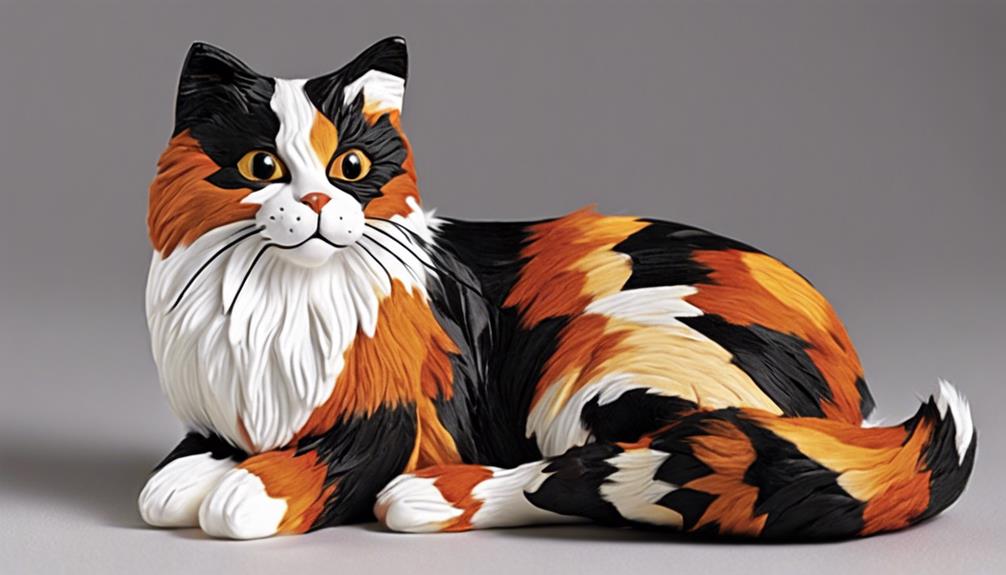
Exploring the genetics behind these captivating coat patterns reveals the science behind the mesmerizing appearance of calico cats.
Calico cats are often mistaken for tortoiseshell cats, which lack the white fur in their coat.
The striking tri-color coat pattern of calico cats showcases a unique combination of white, black, and orange fur. The white fur in calico cats can vary, making up 25-75% of their coat.
Alongside the classic colors, variations like cream, blue-black, brown, and reddish-orange can also be found in their coats.
This distinct tri-color pattern in calico cats isn't just a random occurrence; it's the result of specific genetic factors intricately linked to their coat coloration. Understanding these genetic factors sheds light on how these beautiful felines develop their unique tri-color coat.
Genetics of Calico Cats
Understanding the intricate genetic factors behind the unique tri-color coat of calico cats provides insight into their alluring coloration. Calico cats, known for their striking coat coloring, owe their distinctive appearance to their genetic makeup. These felines are almost always female, a result of their chromosomal composition. Female calico cats possess two X chromosomes, enabling the expression of both black and orange fur patches, creating the beautiful tri-color pattern. On the other hand, male calico cats are rare and typically sterile due to the genetic anomaly Klinefelter Syndrome, where they have an extra X chromosome. The genetics of calico cats play an important role in determining their gender and coat coloration, making them a fascinating subject of study in the feline world.
| Genetic Aspect | Description |
|---|---|
| Gender Determination | Calico cats are almost always female due to their X chromosome makeup. |
| Coat Color Expression | The tri-color pattern in calico cats is a result of the combination of X chromosomes. |
| Male Calico Rarity | Male calico cats are rare and often sterile due to Klinefelter Syndrome. |
Male Calico Cat Rarity
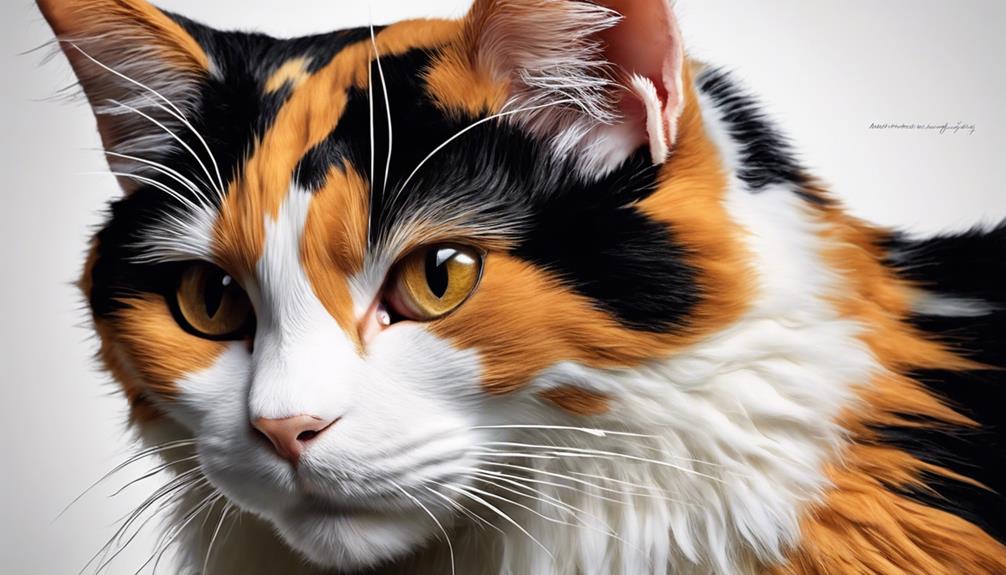
Exceedingly rare, male calico cats make up less than 1% of calico cat populations due to their genetic makeup. These unique felines carry an extra X chromosome (XXY), setting them apart from the typical XY chromosome pattern seen in most male cats.
This additional chromosome not only contributes to their stunning calico coloration but also brings along challenges. Male calico cats are often sterile, unable to father kittens due to genetic abnormalities that impact their fertility. Health issues such as Klinefelter Syndrome are commonly associated with male calicos, affecting their overall well-being.
Despite these obstacles, male calico cats can exhibit the same beautiful and intricate calico patterns as their female counterparts, showcasing a blend of colors in a truly striking manner. Their rarity and special genetic characteristics make them a fascinating subject for study and admiration within the world of feline genetics.
Shorthaired Calicos in Various Breeds
Shorthaired calicos, prevalent in the Domestic Shorthair breed, embody the quintessential American house cat. These shorthaired calico cats, with their uncertain lineage and unique charm, add a touch of mystery to any home.
Despite their widespread presence and inclusion in cat shows under Household Pet divisions, each shorthaired calico retains its individual personality, showcasing the diverse nature of the Domestic Shorthair breed. Their versatility shines through in competitions, where they captivate audiences with their distinct traits and unpredictable behaviors.
From their striking coat patterns to their playful antics, shorthaired calicos bring a sense of wonder and delight to those lucky enough to have them as companions. Embracing the enigma of their origins, these feline friends continue to enchant us with their ever-evolving personalities, making each encounter a new adventure filled with surprises.
Longhaired Calicos: Maine Coons & More
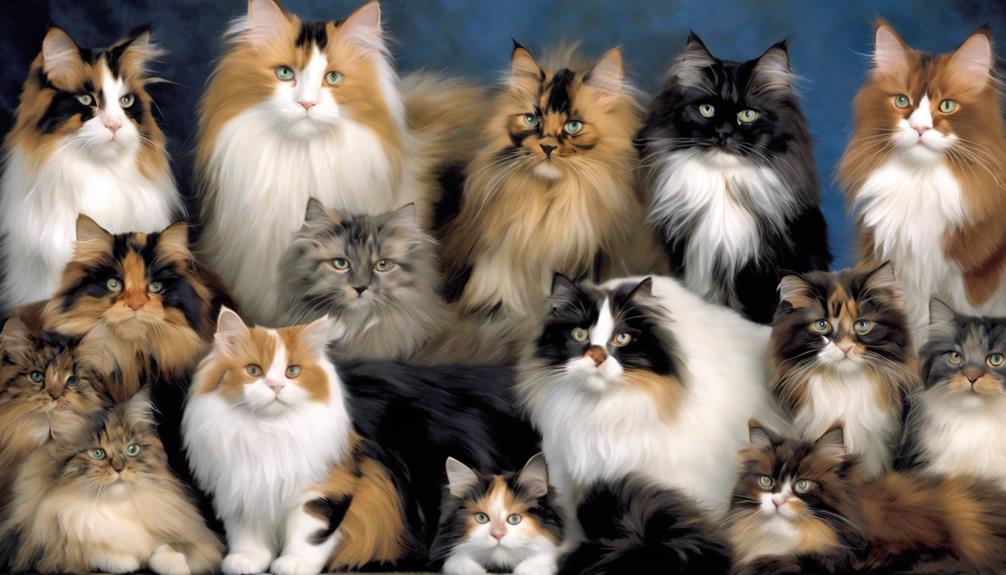
Longhaired calico cats, such as Maine Coons, are known for their striking appearance and friendly personalities. These fluffy felines often have patches of white, black, and orange intertwined in their beautiful coats.
Maine Coon calicos, in particular, are cherished for their loving nature and enchanting longhaired looks.
Maine Coon Longhairs
With their luxurious fur and enchanting tri-color patterns, Maine Coon longhairs stand out as beloved companions among cat enthusiasts. These longhaired calicos boast fluffy coats adorned with striking combinations of white, black, and orange hues.
Their affectionate nature and sociable personalities make Maine Coon longhaired calicos highly sought-after among those looking for a loving feline companion. In addition to their stunning appearance, these cats are known for their gentle temperaments and squirrel-like tails, adding to their charm.
The classic tri-color pattern displayed in their fluffy coats further enhances their beauty, making them a popular choice among longhaired cat lovers. Maine Coon longhaired calicos truly embody the perfect blend of elegance and affection.
Other Longhair Calicos
Longhair calicos beyond the Maine Coon breed display a wide range of enchanting coat patterns and endearing personalities that still captivate cat enthusiasts globally. These fluffy coats, showcased in breeds like the Maine Coon, boast a striking tri-color combination of white, black, and orange, creating a visually stunning and unique appearance.
Longhaired calicos, particularly Maine Coons, are known for their affectionate nature and charming personalities, making them popular choices for those seeking a cat with a loving temperament. The calico coloring in Maine Coons results in eye-catching coat patterns that mesmerize cat lovers.
If you desire a cat with a mix of colors and a delightful disposition, longhaired calicos, especially within breeds like Maine Coons, are sure to steal your heart.
Variations of Calico Cats
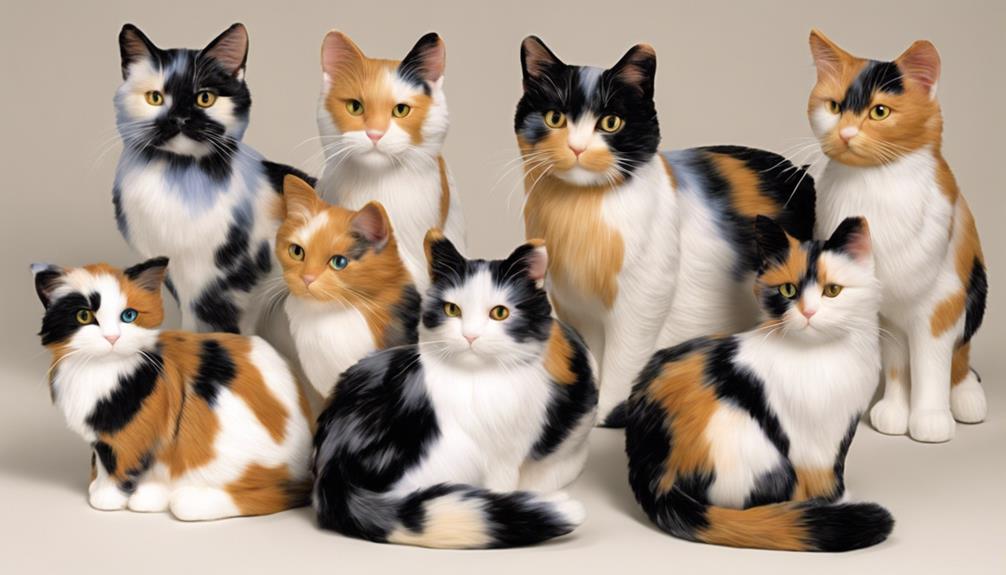
When exploring variations of calico cats, one may notice distinct differences in their coat colors and patterns.
- Dilute calicos can have softer hues like smoke or blue instead of the typical black and cream, giving them a more delicate appearance.
- Patched tabby calicos display tabby characteristics such as M-shaped markings on their foreheads, stripes in their brown and black patches, and tabby markings on various parts of their bodies.
- Traditional calico cats, also known as tortie-and-white cats, exhibit the classic white, black, and orange patches, with white faces, chests, and legs, and either black or orange foreheads, ears, and backs.
- Male calicos are exceptionally rare due to genetic factors like XXY chromosomes, often linked to Klinefelter Syndrome, which can lead to sterility and other genetic abnormalities.
- Shorthaired calicos, like Domestic Shorthairs, make up the majority of American cats, with uncertain lineage but eligibility for entry into cat shows under Household Pet divisions.
Frequently Asked Questions
What Breed of Cat Is Calico?
We love calico cats, known for their beautiful tricolor coats. While they're not a specific breed, this pattern can be found in various cat breeds like American Shorthair, Manx, and Persian. It's fascinating!
What Is the Common Name for a Calico Cat?
We call them calico cats, with their beautiful mix of white, black, and orange fur. Their colors blend like a masterpiece. Calicos are unique and eye-catching, adding a touch of charm to any home.
Is Calico Cat a Rare Breed?
Calico cats are not a rare breed; they are a unique color pattern seen in various breeds. The combination of white, black, and orange fur creates their distinct look. Female calicos are more common due to genetics.
Is a Calico Cat an American Shorthair?
Yes, a calico cat can be an American Shorthair, as calico refers to the coat pattern and not a specific breed. American Shorthairs can come in various colors and patterns, including calico, making them a possible match.
Conclusion
To sum up, calico cats aren't a distinct breed but rather a color pattern that can be found in various breeds. These tri-color felines are a genetic marvel, with their unique coat patterns determined by complex genetics.
Despite their rarity, male calico cats do exist due to a rare genetic anomaly. Whether shorthaired or longhaired, calicos bring a splash of color and charm to any home.
Remember, 'Variety is the spice of life!'
As our Editor-in-Chief, James plays a pivotal role in ensuring the quality and integrity of our content. With a keen eye for detail and a passion for storytelling, James oversees the editorial process here at A Place for Animals. With years of experience in content editing, James ensures that every piece of content meets our high standards of accuracy and clarity. Under James’ guidance, you can rest assured that the content you read is informative and impeccably crafted.
Dogs
How to Choose the Perfect Name for Your Dogs House
Start by considering your dog's personality traits to find the perfect name for their house, reflecting their uniqueness and creating a special space they'll love.
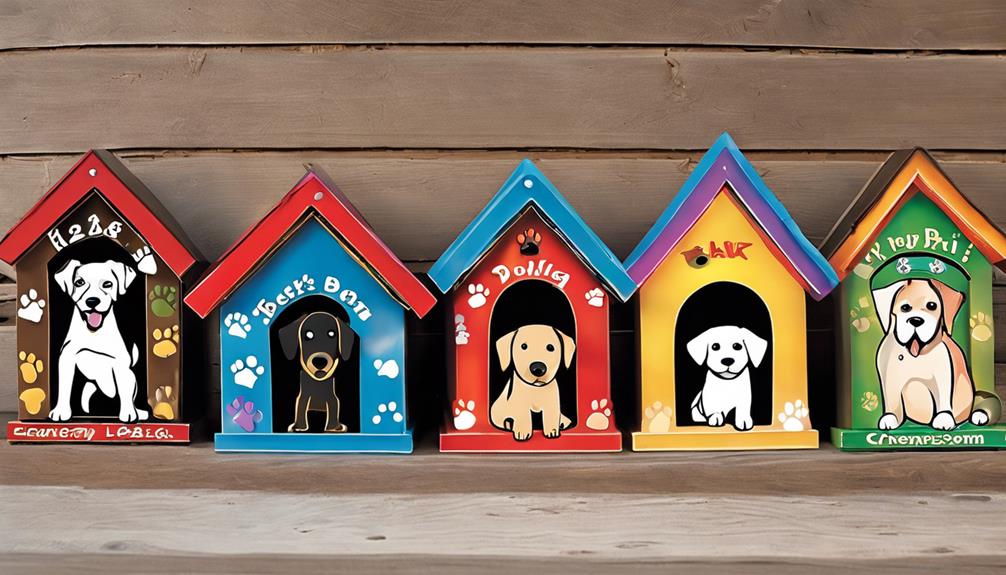
When naming your dog's house, consider their personality traits to find a fitting name reflecting their playfulness or loyalty. Draw inspiration from pop culture by thinking of famous places like Hogwarts or Wakanda. Reflect on your heritage by incorporating traditional names or meaningful words. Think creatively by exploring mythology or clever wordplay. Keep it simple with a memorable name that is easy for your dog to recognize. Choose a name with meaning to create a welcoming space for your furry friend. Add depth and uniqueness to their home with a thoughtful name that resonates with you and your pet.
Key Takeaways
- Consider Your Dog's Personality: Tailor name to match traits, energy level, and special qualities for a personalized touch.
- Draw Inspiration From Pop Culture: Infuse pop culture flair with names from TV shows, movies, or iconic landmarks.
- Reflect on Your Heritage: Incorporate heritage for a unique identity using traditional names, symbols, or meaningful words.
- Think Outside the Box: Explore unconventional sources like mythology or famous buildings for unique naming options.
- Keep It Simple and Memorable: Opt for simple, easily memorable names that reflect your dog's personality.
Consider Your Dogs Personality
When determining a fitting name for your dog's house, it's essential to contemplate their distinctive personality traits. Understanding your dog's personality is key to choosing a name that truly resonates with who they are. By observing their behavior, energy level, and quirks, you can pinpoint characteristics that make them unique. Consider their likes, dislikes, and special qualities when selecting a name for their house.
Tailoring the name to match traits like playfulness, loyalty, or adventurousness can create a sense of belonging for your furry friend.
Personalizing the name based on your dog's individuality and charm will make them feel right at home in their space. Reflecting their favorite toys, activities, or comforting spots in the name adds a personal touch that enhances their connection to their house. Ultimately, the goal is to choose a name that not only sounds good but also captures the essence of your dog's personality, making their house a place where they feel loved and understood.
Draw Inspiration From Pop Culture
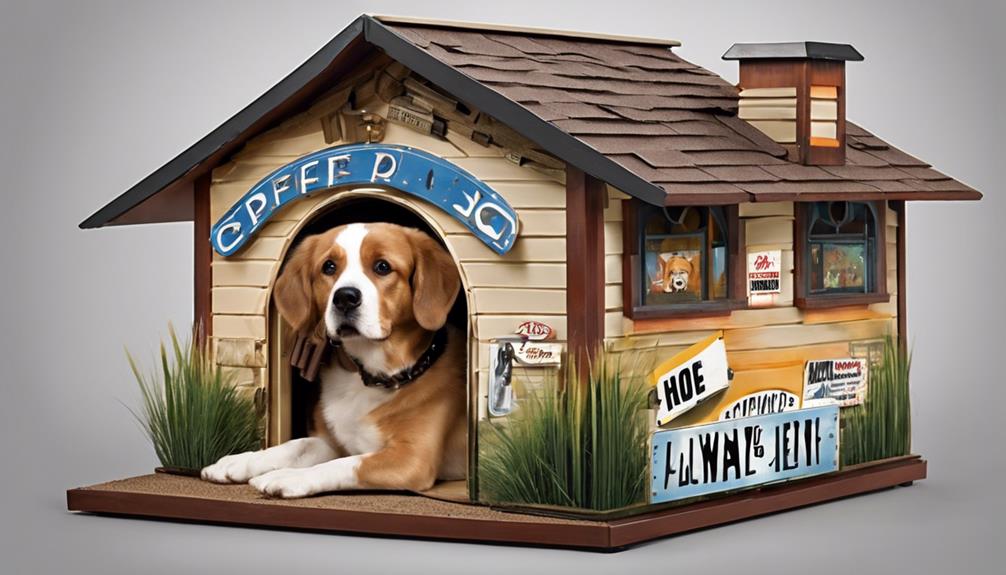
To infuse your dog's house with a touch of pop culture flair, consider drawing inspiration from famous fictional locations, TV shows, movies, music venues, or iconic landmarks when choosing a name.
Popular dog houses can be named after well-known places such as Hogwarts from the Harry Potter series or Jurassic Park for a dinosaur-themed twist. TV enthusiasts might opt for names like Winterfell from Game of Thrones or Hawkins for fans of Stranger Things.
Movie buffs can get creative with names like Wakanda from Black Panther or Middle-earth from The Lord of the Rings. Music lovers could choose names like Abbey Road or Madison Square Garden, adding a musical vibe to their furry friend's abode.
Reflect on Your Heritage
How can we incorporate our heritage into our dog's house name to create a meaningful and unique identity? When choosing a name for our furry friend's abode, drawing from our heritage can add depth and significance to the overall experience. By infusing traditional names, symbols, or meaningful words from our cultural background, we not only create a special connection but also honor our roots. Researching historical figures or landmarks from our heritage can provide inspiration for naming our dog's house, making it a reflection of our background and values. Consider incorporating language or phrases from our heritage to give the house a sense of identity and uniqueness. Below is a table highlighting some examples of dog names inspired by different heritages:
| Heritage | Dog House Name | Meaning |
|---|---|---|
| Celtic | Tara's Haven | Sanctuary |
| Japanese | Sakura Palace | Cherry Blossom Place |
| Native American | Spirit Lodge | Spiritual Dwelling |
| Greek | Olympus Retreat | Home of the Gods |
| African | Simba's Den | Lion's Lair |
Think Outside the Box
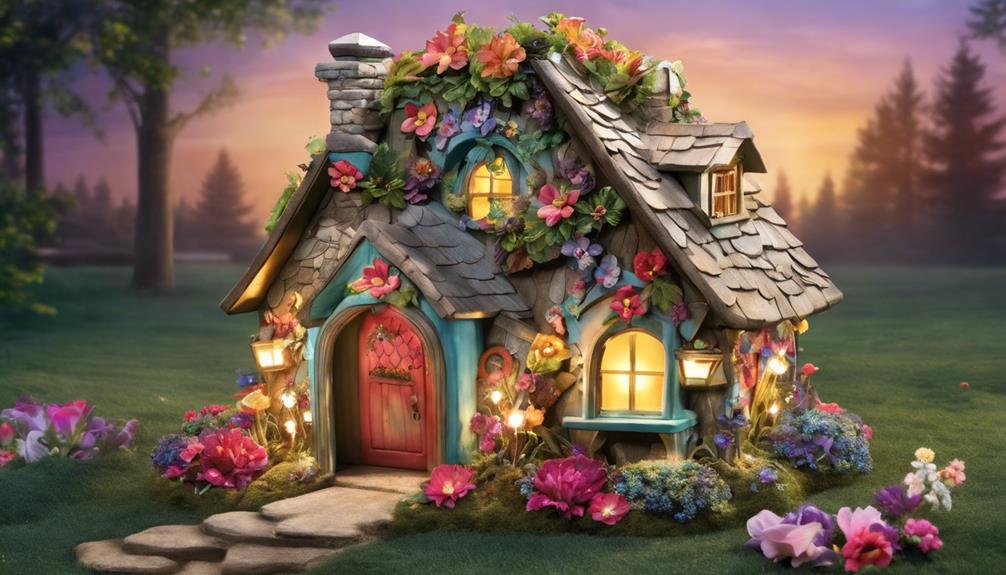
When choosing a name for your dog's house, don't be afraid to think outside the box. Consider unconventional sources of inspiration, like mythology or famous buildings, for a unique and memorable name.
Be Creative With Naming
Let's explore unconventional and unique naming options that showcase creativity and personality for your dog's house. When it comes to naming your furry friend's abode, think beyond the ordinary and consider creative names that reflect your individuality.
Look for inspiration in unexpected places like art, history, or different languages to come up with a distinct and memorable name. Embrace wordplay, puns, or clever combinations of words to add a fun twist to the naming process.
Take into account your dog's special traits, quirks, or habits to personalize the name and make it truly unique. Don't be afraid to break free from traditional naming conventions and let your imagination run wild for a one-of-a-kind name that perfectly suits your dog's house.
Consider Unique Doghouses
Considering unconventional designs for doghouses can provide a unique and personalized shelter for your furry companion. When choosing the perfect dog name, think outside the box and opt for a doghouse that reflects your dog's personality and style.
Customizing the doghouse to match your home's aesthetics not only enhances your outdoor space but also creates a cozy retreat for your pet. Themed doghouses based on your interests or hobbies can add a fun touch to your backyard.
Repurposing materials like old furniture or upcycled items can result in a creative and eco-friendly doghouse design. Investing in a quality, durable doghouse guarantees comfort and protection for your furry friend, making their house a true home.
Keep It Simple and Memorable

To guarantee a strong connection with your furry companion, opt for a dog house name that is both simple and easily memorable. When naming your dog's house, keeping it straightforward and catchy can enhance the bond between you and your pet. Consider names that are easy to pronounce and remember for quick communication. Avoid lengthy or complex names that might confuse your dog when you call out to them. Opt for unique names that stand out and reflect your dog's personality. Choosing a name with one or two syllables can facilitate effective communication and recognition. Below is a table to help you brainstorm simple and memorable names for your dog's house:
| Simple and Memorable Dog House Names |
|---|
| Snug Haven |
| Paws Retreat |
| Bark Manor |
Choose a Name With Meaning
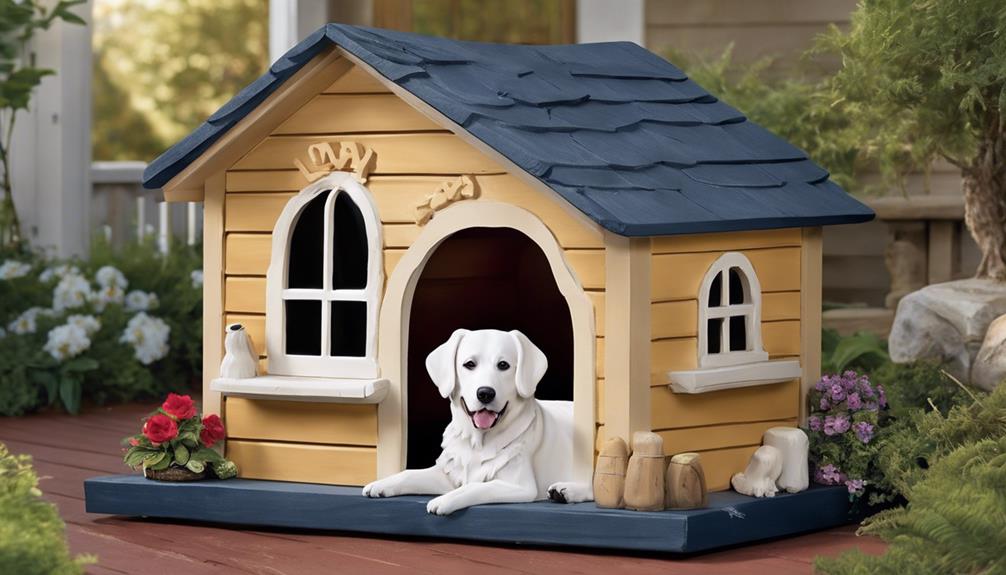
When selecting a name for your dog's house, it's essential to choose one that holds personal significance to you. This could be a place that holds special memories or a name that reflects your dog's unique personality.
Personal Significance Matters
Selecting a dog's house name with personal significance adds a meaningful touch to your furry friend's identity. When you choose a name that holds a special place in your heart, whether it's a favorite place, a cherished memory, or a significant event in your life, you're creating a strong emotional bond with your canine companion.
Reflecting on your own experiences and values can guide you in selecting a name that resonates with you on a deeper level, making the connection between you and your dog even more profound. Names with personal significance serve as constant reminders of special moments or connections in your life, enhancing the overall experience of having a furry companion in your home.
Reflect Dogs Personality
Reflecting on our dog's unique personality traits is key when choosing a name with meaning that will deepen our bond with our furry companion. When considering names that sound meaningful, here are three things to keep in mind:
- Personality Traits: Opt for names that align with your dog's characteristics, whether they're playful, loyal, or energetic.
- Appearance and Habits: Take into account your dog's physical attributes, habits, and quirks when selecting a name that resonates with who they are.
- Personal Connection: Choose names that hold significance to you or have a personal connection, as this can make the name extra special for your furry friend.
Frequently Asked Questions
What Is the Name of a Dog's House?
We call a dog's house a doghouse or kennel. It is a cozy retreat for our furry friends. Providing shelter and comfort, it becomes their safe haven. Our pets cherish their doghouses, making them a special part of our homes.
What Name Do Dogs Respond to Best?
We find that dogs respond best to names with short, choppy sounds containing hard consonants. Avoid names that sound like commands. Opt for distinct names linked to treats for positive responses. Consistent use during training aids learning.
What Names Should Dogs Avoid?
We should steer clear of names that sound like common commands, are hard to pronounce, or have negative connotations. It's important to choose names that won't confuse or hinder our furry friends' training and well-being.
What Is the Name Dogs Home?
Our furry friend's home is where they find comfort and shelter. It's their safe haven, a place of love and warmth. We can make it special by giving it a name that reflects their personality and our bond.
Conclusion
To sum up, choosing the perfect name for your dog's house is a fun and creative process that requires careful consideration. Just like building a house, the name you choose should reflect your dog's personality and create a welcoming atmosphere.
By drawing inspiration from various sources and thinking outside the box, you can find a name that's both meaningful and memorable. Remember, the name you choose will be a reflection of your love and care for your furry friend.
As our Editor-in-Chief, James plays a pivotal role in ensuring the quality and integrity of our content. With a keen eye for detail and a passion for storytelling, James oversees the editorial process here at A Place for Animals. With years of experience in content editing, James ensures that every piece of content meets our high standards of accuracy and clarity. Under James’ guidance, you can rest assured that the content you read is informative and impeccably crafted.
Dogs
How Much Do Pomskies Cost: A Comprehensive Guide
Intrigued by the cost of Pomskies? Uncover the factors influencing their price and discover what makes these hybrid dogs unique.
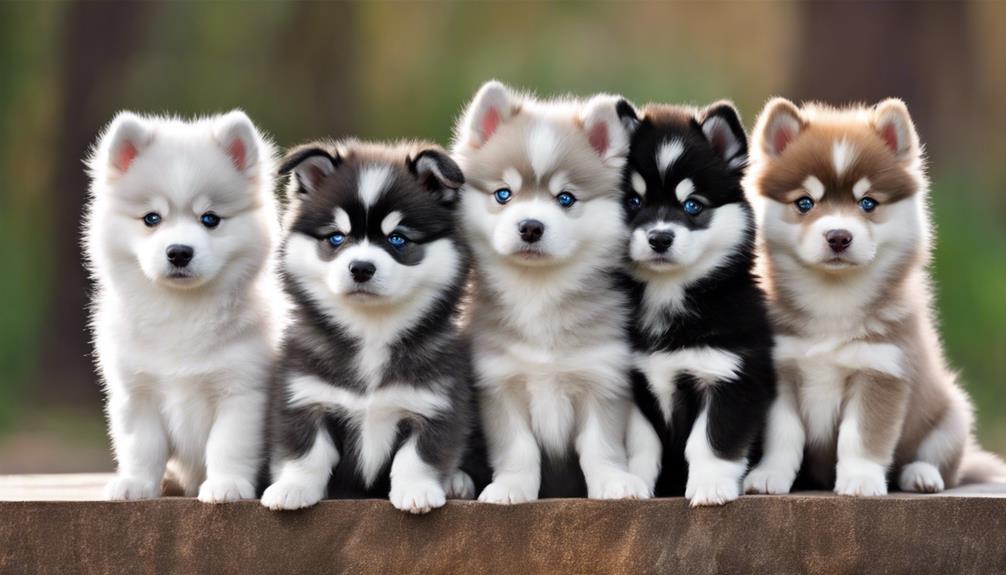
When considering buying a Pomsky, it is crucial to take into account different factors that may affect the price. Reputable breeders are a key factor in determining pricing, with smaller Pomskies, particularly teacup ones, typically fetching higher prices. Additionally, rare coat colors can further drive up the cost.
Overall, the size, color, and generation of the Pomsky are key in determining their cost. Understanding these factors can help you make an informed decision about your purchase.
Key Takeaways
- Reputable breeders impact pricing.
- Smaller Pomskies are more expensive.
- Rare coat colors increase price.
- Adult Pomskies cost less than puppies.
- Adoption fees range from $150 to $500.
Factors Influencing Pomsky Price
When considering the cost of Pomskies, various factors greatly influence their prices, ranging from $1,500 to $6,000. Pomsky breeders play an important role in determining the cost of these designer dogs. Reputable breeders with a history of breeding healthy and well-tempered Pomskies often charge higher prices due to the quality of their pups.
The size of a Pomsky also plays a significant role in its price tag. Generally, smaller Pomskies are more expensive, with teacup Pomskies fetching the highest prices. Teacup Pomskies are particularly costly due to their tiny size, which results in smaller litters and potential health issues that require extra care and attention.
In addition, coat color can greatly impact the cost of a Pomsky. Rare colors like Blue Merle are highly sought after and can increase the price substantially. Moreover, the generation of a Pomsky, such as F1 or F2, also affects pricing, with F1 typically being more affordable compared to later generations. Lineage, health issues, and breeder reputation all intertwine to determine the final cost of these adorable hybrid dogs.
Impact of Size on Pomsky Cost
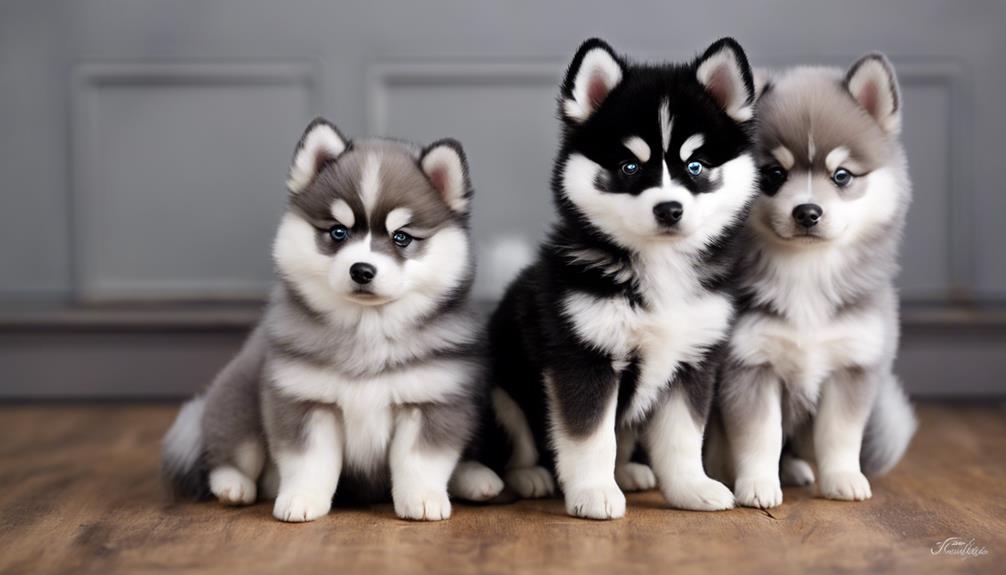
The size of a Pomsky greatly influences its cost, with smaller Pomskies typically commanding higher prices due to their rarity and market demand. Teacup Pomskies, being the smallest size category, are the most expensive due to factors such as smaller litters and potential health issues associated with miniaturization.
On the other hand, larger Pomskies may be more affordable as they're more common in the market. The pricing of Pomskies is intricately linked to their size, affecting their desirability and overall cost. Potential Pomsky owners should consider these factors when deciding on the size of their future pet, balancing cost with preferences.
While smaller Pomskies come at a premium due to their scarcity and high demand, it's essential to also factor in the potential health risks and associated costs that may come with Teacup Pomskies. Ultimately, the size of a Pomsky plays a significant role in determining its price in the market.
Influence of Coat Color on Pomsky Price
Rare coat colors, such as Blue Merle, can significantly elevate the price of a Pomsky. The Siberian Husky and Pomeranian mix is already a highly sought-after breed, but certain coat colors and patterns can make them even more coveted.
Here are some key points to ponder regarding the impact of coat color on Pomsky price:
- Unique Coat Colors: Pomskies with rare coat hues, like Blue Merle or piebald, may fetch higher prices due to their scarcity and the heightened interest in such distinctive variations.
- Popular Choices: Breeders often price Pomskies with coat colors that are currently popular or in high demand among potential buyers.
- Influence of Coat Patterns: Specific designs such as particolor or markings like black, white, red, and gray can also influence the final price of a Pomsky, with some variations being more desired than others.
When contemplating acquiring a Pomsky, it's crucial to take into account how the coat color and pattern can impact the overall price of these charming hybrid dogs.
Comparison of Adult Vs Puppy Prices
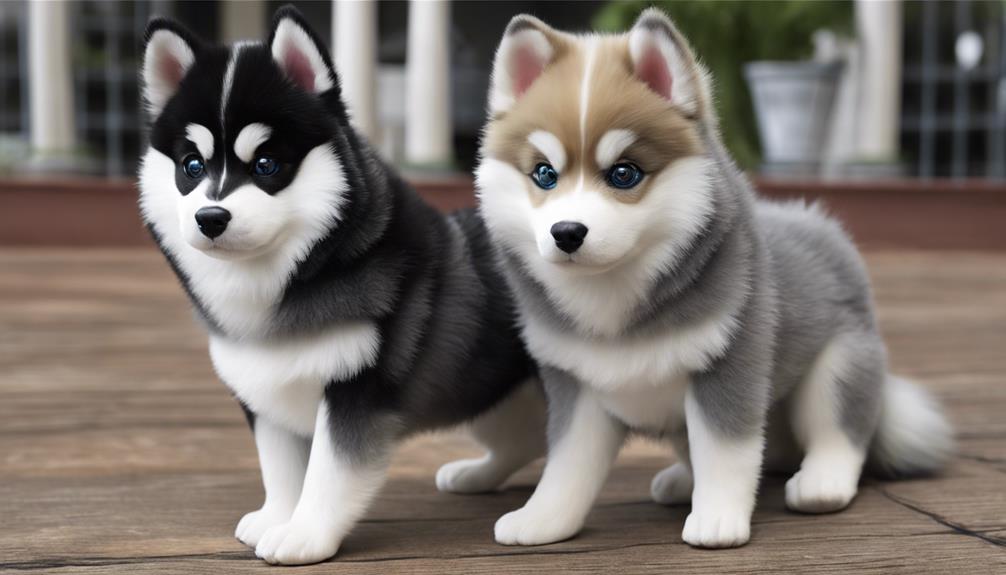
Considering the factors affecting pricing in the Pomsky market, it is important to mention that adult Pomskies generally come at a lower cost compared to their younger counterparts. Adult Pomskies can range from $1,500 to $5,000, while puppies typically cost between $2,000 and $6,000. The price variation is influenced by factors such as size, coat color, generation, training, and temperament. Adult Pomskies may be a more budget-friendly option for those seeking a Pomsky companion without the higher initial investment required for a puppy. Below is a comparison table illustrating the price differences between adult Pomskies and puppies based on various factors:
| Factors | Adult Pomskies Price Range | Puppy Price Range |
|---|---|---|
| Size | $1,500 – $5,000 | $2,000 – $6,000 |
| Coat Color | $1,500 – $5,000 | $2,000 – $6,000 |
| Generation | $1,500 – $5,000 | $2,000 – $6,000 |
Buy Vs Adopt: Pomsky Cost Considerations
When deciding between purchasing or adopting a Pomsky, one must carefully evaluate the cost considerations associated with each option.
- Adoption fees: Adoption fees for Pomskies range from $150 to $500, much lower than buying from a breeder.
- Financial considerations: Adopting a Pomsky can save money and provide a loving home to a dog in need.
- Ethical aspects: Buying a Pomsky from a breeder can cost between $1,500 to $6,000, depending on various factors. Breeders offer guarantees on health and lineage, but adoption offers a chance to give a home to a rescued dog.
Consider the financial implications and ethical responsibilities of both options before making a decision.
While buying from a breeder may provide certain guarantees, adopting can offer the joy of giving a rescued dog a second chance at happiness.
Ultimately, the choice between buying and adopting a Pomsky depends on personal values, financial capabilities, and the desire to support ethical pet practices.
Frequently Asked Questions
What Is the Average Price of a Pomsky?
We've found that the average price of a Pomsky typically falls between $1,500 and $5,000. This range varies based on factors like size, coat color, lineage, and breeder reputation.
Breeders may have different pricing structures influenced by individual Pomsky traits. Puppies with unique markings or eye colors often command higher prices. Artificial insemination for breeding can also contribute to the overall cost.
Why Are Pomsky Puppies so Expensive?
Pomsky puppies are expensive due to their high demand as a designer crossbreed. Their lovely temperament, striking looks, and Husky coat with blue eyes contribute to their price. Pomskies are smaller and more manageable than Huskies, increasing their desirability and cost.
Factors like size, coat color, generation, lineage, breeder's reputation, location, and age impact Pomsky prices. The rarity of certain coat colors and smaller Pomsky sizes can notably increase their cost.
How Much Is Pet Insurance for a Pomsky?
Pet insurance for a Pomsky can range from $200 to $700 annually based on coverage. It's important to take into account factors like age, health history, and location when selecting a plan. We must also take into consideration spaying or neutering costs, which impact insurance rates.
What Is the Lifespan of a Pomsky?
The lifespan of a Pomsky typically ranges from 13 to 15 years. Proper care, including nutrition, exercise, and regular vet check-ups, plays an essential role in ensuring a Pomsky's longevity.
Despite being generally healthy, Pomskies may be prone to health issues like hip dysplasia and eye problems.
What Factors Determine the Cost of a Pomsky?
When considering the pomsky cost guide, several factors play a crucial role in determining the price of this designer breed. The primary factors include the pomsky’s lineage, size, color, and markings, as well as the breeder’s reputation and location. Additionally, the demand for pomskies can also impact their cost.
Can Convincing My Parents to Get a Dog Affect the Cost of Owning a Pomsky?
If you convince your parents to get a dog like a Pomsky, it can definitely affect the cost of owning one. You will need to consider expenses like food, grooming, and veterinary care. Additionally, purchasing the dog itself can be a significant upfront cost. It’s important to carefully weigh the financial responsibilities before making the decision.
Conclusion
To sum up, the cost of pomskies can vary greatly depending on various factors such as size, coat color, age, and whether you choose to buy or adopt.
Remember, when it comes to purchasing a pomsky, it's not just about the price tag – it's about the love and care you'll provide for your furry friend.
So, whether you're willing to splurge on a designer pup or opt for a rescue, make sure to take all the factors into account before making your decision.
As our Editor-in-Chief, James plays a pivotal role in ensuring the quality and integrity of our content. With a keen eye for detail and a passion for storytelling, James oversees the editorial process here at A Place for Animals. With years of experience in content editing, James ensures that every piece of content meets our high standards of accuracy and clarity. Under James’ guidance, you can rest assured that the content you read is informative and impeccably crafted.
Dogs
Why Does My Dog Have Diarrhea? Understanding the Causes
Ongoing diarrhea in dogs can be caused by a variety of factors, from dietary changes to underlying infections, making it crucial to explore the root cause.

If our dog has diarrhea, it may be caused by different factors. Changes in diet, consuming disagreeable substances, and even food allergies can lead to loose stools, vomiting, and other symptoms. Infections such as parvovirus, parasites, or intestinal disorders could also be to blame.
If the issues persist, seeking veterinary help is essential to identify the exact cause and provide appropriate treatment. Understanding these causes is vital for our dog's health and comfort.
Key Takeaways
- Dietary changes, infections, parasites, and intestinal disorders are common causes of dog diarrhea.
- Food allergies, spoiled food, and abrupt diet changes can trigger diarrhea in dogs.
- Infections like parvovirus and parasites like Giardia can lead to diarrhea in dogs.
- Stress and changes in routine can disrupt hormone balance and cause diarrhea in dogs.
- Veterinary assistance is crucial for accurate diagnosis and treatment of dog diarrhea.
Common Causes of Dog Diarrhea
Vital causes of dog diarrhea often stem from dietary changes or the ingestion of disagreeable substances. When our furry friends experience diarrhea, it can be a worrisome and uncomfortable ordeal for both them and us. The symptoms are usually quite apparent – frequent loose or watery stools, straining to defecate, vomiting, lethargy, and sometimes blood in the stool. It's imperative to understand that diarrhea in dogs can be caused by a variety of factors, ranging from mild issues like dietary indiscretions to more severe conditions like infections or underlying health problems.
While some cases of diarrhea may resolve on their own, it's important to monitor your dog closely and seek veterinary help if the symptoms persist for more than a day or two, or if they're accompanied by other concerning signs. Your vet may recommend medications, dietary changes, or further diagnostic tests to determine the exact cause of your dog's diarrhea and provide appropriate treatment. Remember, prompt attention and care can help alleviate your dog's discomfort and safeguard their health and well-being.
Dietary Indiscretions and Allergies
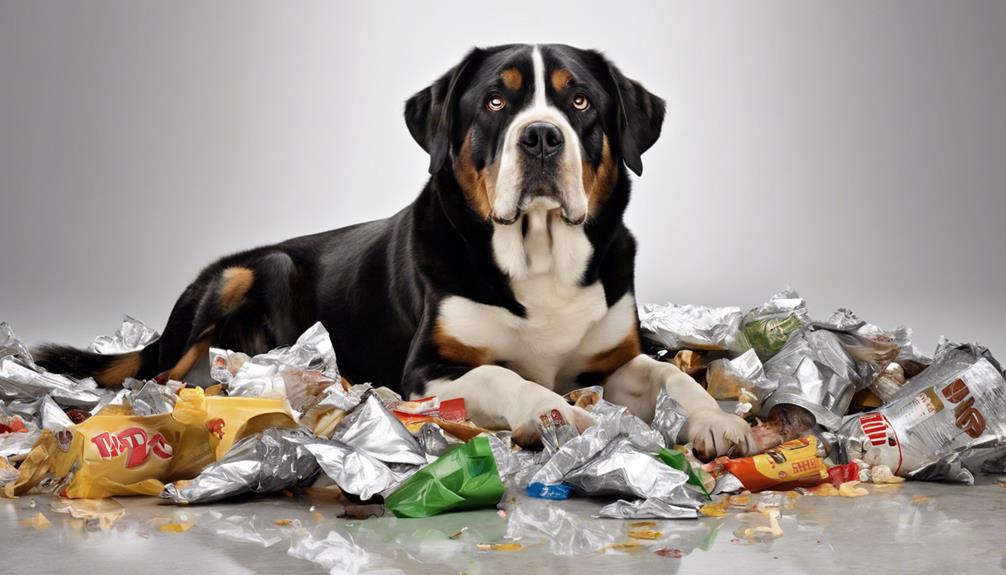
When dogs consume inappropriate or allergenic substances, it can lead to gastrointestinal disturbances such as diarrhea. Here are some key points to keep in mind when understanding dietary triggers for diarrhea in dogs:
- Food Allergies: Dogs can develop diarrhea as a result of food allergies, where certain ingredients provoke an immune response leading to gastrointestinal upset.
- Spoiled Food: Consumption of spoiled or contaminated food can cause diarrhea in dogs due to bacterial overgrowth or toxins present in the food.
- Abrupt Diet Changes: Suddenly altering your dog's diet, whether by shifting to a new brand of food or introducing new ingredients, can disrupt their digestive system and result in loose stools.
- Toxic Foods: Foods like chocolate, onions, garlic, and grapes are poisonous to dogs and can cause digestive issues, including diarrhea.
Identifying and managing specific dietary triggers, avoiding toxic foods, and gradually shifting to new diets can help prevent and alleviate diarrhea in dogs.
Infections and Parasites
Infections and parasites pose significant risks to dogs, potentially leading to gastrointestinal disturbances such as diarrhea. Common culprits include parvovirus, distemper, and bacterial infections, all of which can trigger diarrhea in our furry companions. Additionally, parasites like Giardia, hookworms, and roundworms are known to cause gastrointestinal issues and diarrhea in dogs.
When infections or parasites are the root cause of diarrhea, dogs may experience severe symptoms such as dehydration. It's important to adhere to regular deworming and vaccination schedules to help prevent these infections and parasitic infestations that can lead to diarrhea. Seeking veterinary assistance is essential for accurate diagnosis and treatment.
Veterinary testing is often required to pinpoint the specific infection or parasite causing the diarrhea, enabling targeted treatment and a quicker recovery for our beloved pets. Remember, early detection and intervention are key to ensuring our dogs' health and well-being when facing infections or parasites.
Intestinal Disorders and Diseases
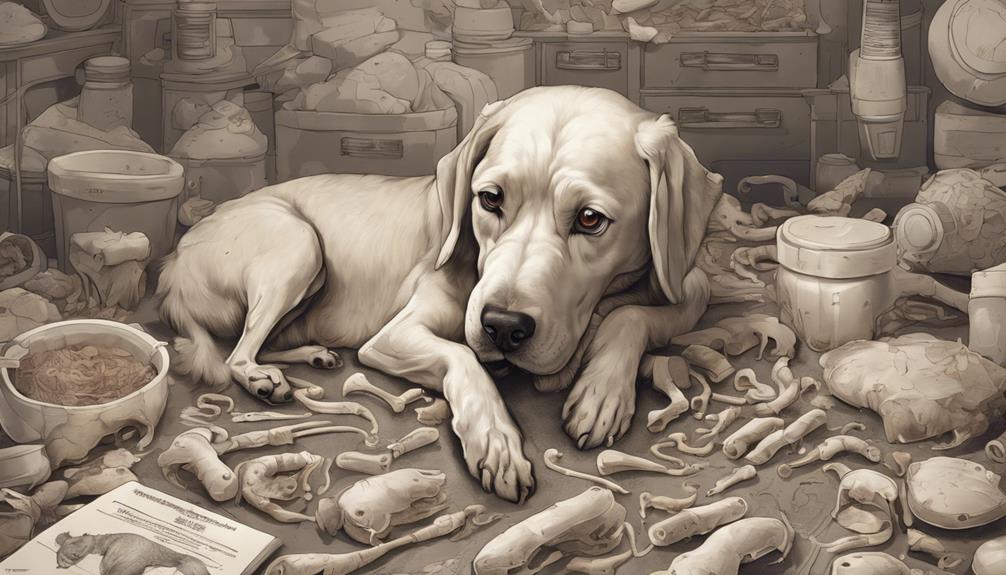
What symptoms can indicate the presence of intestinal disorders and diseases in dogs? Here are some key indicators to watch for:
- Inflammatory Bowel Disease (IBD): Dogs with IBD may experience chronic diarrhea, often accompanied by weight loss and vomiting.
- Intestinal Parasites: Infestations of parasites like giardia or worms can lead to diarrhea, which may contain blood or mucus.
- Pancreatitis and Colitis: Conditions such as pancreatitis and colitis can cause gastrointestinal upset, resulting in diarrhea with varying degrees of severity.
- Bacterial Gastroenteritis: Infections from bacteria can trigger acute diarrhea in dogs, often with additional symptoms like fever and lethargy.
Each of these factors can contribute to gastrointestinal issues in dogs. Monitoring your dog's bowel movements and overall health closely is crucial, as chronic diarrhea or persistent gastrointestinal upset could signal an underlying problem that requires veterinary attention.
Additionally, conditions like kidney or liver issues can also manifest as diarrhea, underscoring the importance of timely diagnosis and treatment.
Stress and Other Factors
Moving from the discussion on intestinal disorders and diseases in dogs, stress and other factors play a significant role in triggering diarrhea in canine companions. Stress can disrupt the delicate balance of hormones in a dog's body, affecting the gastrointestinal system and leading to diarrhea. Changes in routine, environment, or social interactions can all contribute to stress-induced diarrhea in dogs.
Anxiety, fear, and separation from their owners or familiar environments can also play a part in causing digestive upset and diarrhea in dogs. Fortunately, stress-related diarrhea can be managed through various techniques such as behavior modification, environmental enrichment, and implementing calming strategies.
Frequently Asked Questions
Do Dogs Sometimes Get Diarrhea for No Reason?
Yes, dogs can sometimes get diarrhea for no obvious reason. Factors like stress, dietary changes, or minor lapses can trigger this problem. Typically, these episodes resolve on their own.
Monitoring your dog's condition is vital. If the diarrhea continues or is accompanied by concerning symptoms, seeking advice from a veterinarian is recommended. It's important to safeguard your dog's well-being and address any health concerns promptly.
What to Do if Your Dog Has Diarrhea but Is Acting Normal?
If your dog has diarrhea but is acting normal, it could indicate a minor tummy problem. Keep an eye out for other symptoms like vomiting or weakness. Ensure your furry friend stays hydrated and try a bland diet.
If the situation continues or worsens, it's wise to seek advice from a vet for proper care. Remember, our pups' well-being is a top priority, so prompt attention to their health is essential.
At What Point Should I Be Worried About My Dog Having Diarrhea?
If our dog experiences diarrhea, we should be concerned if it persists or worsens over a day, especially if accompanied by signs like blood in the stool, weakness, or dehydration.
Straining to pass watery stool might suggest a potential blockage needing urgent attention.
Monitoring for these symptoms and seeking prompt veterinary care can aid in managing any underlying health issues effectively.
What if My Dog Has Diarrhea but Still Eating and Drinking?
If our dog has diarrhea but is still eating and drinking, it could be due to mild gastrointestinal upset from dietary indiscretion or stress. Though appetite and hydration are important signs, underlying issues like infections or parasites could be present.
Monitoring for additional symptoms like vomiting, weakness, or blood in stool is essential. Providing a bland diet and ensuring access to fresh water can help.
Consulting a veterinarian is recommended to rule out serious causes and determine the best course of action.
Can Toxic Foods for Dogs Cause Diarrhea?
Yes, toxic foods for dogs can cause diarrhea. Certain foods like chocolate, grapes, and onions are toxic to dogs and can lead to gastrointestinal issues such as diarrhea. It’s important for pet owners to be aware of what foods are harmful and to keep them out of reach of their furry friends.
Conclusion
So, next time your furry friend is experiencing some explosive bowel movements, remember that there could be a multitude of reasons behind it. From dietary indiscretions to stress, the causes of dog diarrhea are vast and varied.
It's a real crapshoot trying to figure out what's causing all the mess, but with a little detective work and maybe a trip to the vet, you'll hopefully get to the bottom of it.
As our Editor-in-Chief, James plays a pivotal role in ensuring the quality and integrity of our content. With a keen eye for detail and a passion for storytelling, James oversees the editorial process here at A Place for Animals. With years of experience in content editing, James ensures that every piece of content meets our high standards of accuracy and clarity. Under James’ guidance, you can rest assured that the content you read is informative and impeccably crafted.
-

 Vetted2 months ago
Vetted2 months ago15 Best Cat Foods for Managing Hyperthyroidism – Vet Approved and Feline Friendly
-

 Vetted2 months ago
Vetted2 months ago15 Best Dog Foods for Kidney Disease – Expert Recommendations for Your Pet's Health
-

 Animal Facts2 months ago
Animal Facts2 months agoSpring Animals: A Guide to Seasonal Wildlife
-

 Cats15 hours ago
Cats15 hours agoTop 5 Cat Breeders in Arkansas: A Guide
-

 Vetted2 months ago
Vetted2 months ago15 Best Fresh Dog Food Delivery Services for Your Pup's Health and Happiness
-

 Rabbits2 months ago
Rabbits2 months agoExploring Rabbit Holes: What Do They Look Like?
-

 Pets2 months ago
Pets2 months agoLatest Pet Statistics in US – Trends & Insights in 2024
-
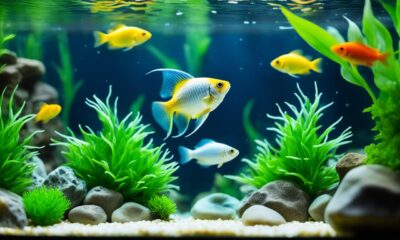
 Fish2 months ago
Fish2 months agoKeeping Your Sucker Fish Thriving at Home


















